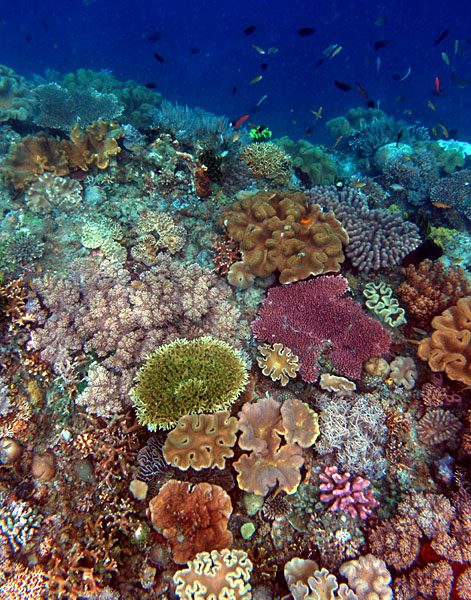Habitat & Geography
Hermodice carunculata, or a type of fireworm, can be seen all
across the world. The fireworm is found in coral reefs and littoral
areas in seas and oceans in tropical and temperate waters (Perez &
Gomes 2012; Wolf & Nugues 2013).

The tropical habitat can be found in
many different geographical locations, which tend to be near the
Equator. The most common sites for researching the fireworm are the
Caribbean Sea (Wolf & Nugues 2012) and the Western Atlantic Ocean
(Perez & Gomes 2012). However, H. carunculata can be found off the
coast of Brazil (Moreira et al. 2013), Australia (Gleibs & Mebs
1999), and the Mediterranean Sea (Arias et al. 2013). The main
habitat requirement for Hermodice carunculata is available coral to
eat (Perez & Gomes). The most common location for coral is a coral
reef, so most fireworms reside within coral reefs.
Fireworms are destroying their own
habitats by eating coral and carrying around bacteria, which causes
damage to coral (Perez & Gomes 2012; Moreira et al. 2013). The
fireworm’s overconsumption of coral is causing algae to cover
lesions in coral and affecting the overall health of the reef; these
issues have caused coral cover to significantly reduce in the
Indo-Pacific reefs (Perez & Gomes 2012). In addition, coral usually
becomes bleached by various heterotrophic bacteria when temperatures
are around 30°C, but recovered; the bacteria also would die when the
temperatures reduced during the winter (Sussman et al. 2003). Now,
bacteria are able to survive by living inside of Hermodice
carunculata during the winter and attack coral in the spring
(Moreira et al. 2013). Research is being conduct in effort to
prevent the bleaching of coral due to the increased survival of
bacteria such as vibrios, specifically Vibrio shiloi (Moreira et al.
2013; Sussman et al. 2003).
 Many other types of organisms reside
in the same coral reef habitat as Hermodice carunculata. Some
organisms that are feed on by the fireworm are algae, anemones,
zoanthids, and gorgonids, as well as various types of coral
including octocorals, scleractinans, and hydrocorals (Perez & Gomes
2012). Also there are the many types of bacteria in the reefs,
specifically those that cause the coral bleaching (Sussman et al.
2003). Other various organisms include starfish, fish i.e.
Chaetodon, mussels, and crustaceans (Gleibs & Mebs 1999). There are
also different species of fireworms such as Eurythoe complanata
and
Eurythoe laevisetis found in certain environments, mainly the
Mediterranean Sea (Arias et al. 2013). Even dinoflagellates can be
found in the reef habitat (Gleibs & Mebs 1999). The organisms found
in the same habitat as H. carunculata belong to the Bacteria and
Eukaryote domains, Archeplastida, Opisthokonta, and Alveolata
clades, and various animal phyla such as Annelida, Mollusca,
Cnidaria, Echinodermata, and Chordata.
Many other types of organisms reside
in the same coral reef habitat as Hermodice carunculata. Some
organisms that are feed on by the fireworm are algae, anemones,
zoanthids, and gorgonids, as well as various types of coral
including octocorals, scleractinans, and hydrocorals (Perez & Gomes
2012). Also there are the many types of bacteria in the reefs,
specifically those that cause the coral bleaching (Sussman et al.
2003). Other various organisms include starfish, fish i.e.
Chaetodon, mussels, and crustaceans (Gleibs & Mebs 1999). There are
also different species of fireworms such as Eurythoe complanata
and
Eurythoe laevisetis found in certain environments, mainly the
Mediterranean Sea (Arias et al. 2013). Even dinoflagellates can be
found in the reef habitat (Gleibs & Mebs 1999). The organisms found
in the same habitat as H. carunculata belong to the Bacteria and
Eukaryote domains, Archeplastida, Opisthokonta, and Alveolata
clades, and various animal phyla such as Annelida, Mollusca,
Cnidaria, Echinodermata, and Chordata.
A variety of organisms live in the same coral reefs as Hermodice
carunculata such as:
Hippocampus bargibanti,
Aplysia dactylomela,
Pseudoceros bifurcus,
Pterois miles,
Thenus orientalis,
Photeros annecohenae,
Stenella frontalis,
Holothuria pardalis,
Salinispora tropica, and
Lysmata amboinensis!
Next: Interactions
References for this page
Return Home
